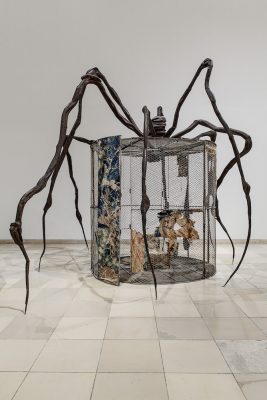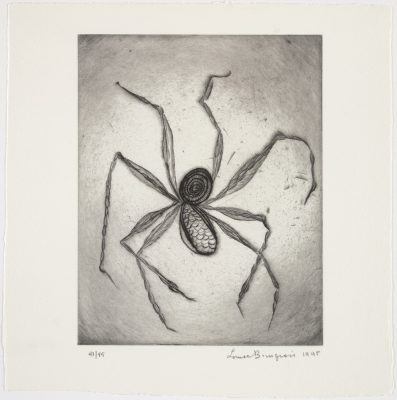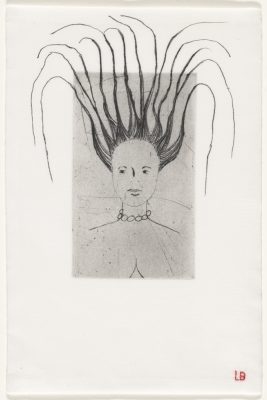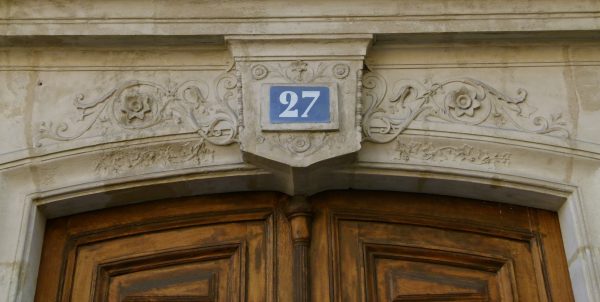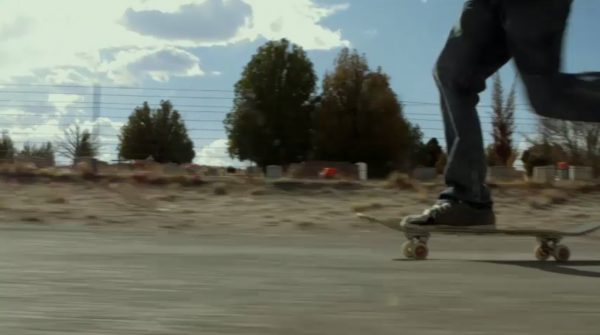I’ve been keeping a mental list of all the pieces of art that I’ve nursed Leo in front of this past year. I remember at first, the two times I was out in public afterwards, both times at the Whitney, I was nervous to take my breast out, because Leo was crying and people were staring, I felt panicky and self-conscious, which I think made the baby more agitated. I became used to taking my breast out in art spaces, and began to savour it with sometimes a fatigued perversity and other times something more sacred, like the installation at the Lygia Pape show at the Met Breuer, in the corner of the nearly pitch-black room where gold thread made geometric curtains like beams of light, or recently on a bench in front of the El Greco ‘Holy Family’ at the Met, the way in which Mary presses down on her breast and points the nipple towards baby Jesus, both her and Joseph gazing downwards at the central point of the baby, the baby’s little hand on his mother’s hand. I nursed Leo outside the bubblegum phallic Franz West sculpture at MASS MoCA, amidst the industrial landscape and grey cool light, her straddling me, downy head bobbing back and forth between each breast, and this fall in front of a Harry Dodge video at the New Museum’s gender show, because there was a bench to sit on. I figured if there were so many penises in that room it was okay to have my breast peek out through my leather jacket, like a floppy blue-veined sac of a sculpture, scratched and sad. At the MoMA it is difficult to find a place to breastfeed. I didn’t get to see all of the Louise Lawler show because it had taken all of our energy to get there on the subway, and it was almost closing time, and I couldn’t find anywhere I felt comfortable to nurse, as Leo was still quite young and I still felt shaky and strange occupying public space in the city with a baby. A maintenance worker told me I could sit on the wooden pews in the atrium that were part of the exhibit, but the security guard told me I couldn’t as I approached, and I apologised, but I kept on thinking that if Louise Lawler were there she probably would have let me breastfeed on the pews, because isn’t her work about critiquing these institutional spaces? At the MoMA I’ve taken to nursing on the second floor lounge, outside the temporary gift shop, on one of the leather benches. I used to be so aware of people staring at me when I took my breast out, and I’m imagining they probably do look, as Leo is now a toddler, a year old this month, but I’ve stopped even thinking about someone staring at me, at least when with the baby, and there’s a freedom to that. They might look at me but I don’t look any more at them looking at me. It’s just the two of us, together.
As I’m writing this I get an email from Clutch, because I emailed them that I was looking at Catherine Opie’s self-portrait of her breastfeeding her one-year-old baby, thinking how strange it was, that I was turning 40 next month and would have my first mammogram when my breasts were still full of milk — what a reminder of death and life at the same time, how much more can my body be wrung out and twisted — and that I planned to nurse Leo through the second year, even though I keep on being told I’m not going to feel like I have my body back until she weans. I don’t know why I’m still nursing, it’s something my body is doing and we do it together and it hasn’t stopped yet, it’s fluid, when it begins, when it ends, each session is fluid, and I feel time has been fluid, with the baby, there’s no clear demarcations of boundaries, of time, our bodies, the self. What is a body, does one ever really get it back, that’s what I wonder. This is something I know Clutch is interested in, transformations and time and the body. It turns out they had just shown the Opie photograph in their queer lit class, and all the students commented that the baby seemed too old, and Clutch had no idea, how to tell the age of babies, which I wouldn’t have either, a year ago. I found it funny, the students’ judgement about the body and taboo, in a class on queerness. I wrote them that I loved how you can still see the scarring of Pervert across Opie’s chest, from her previous self-portrait, something of how the body scars and bleeds, holds history and time, how even her breasts out reference her past work. How Opie is celebrating the postpartum body, the bigger, aching, drooping breast, held buoyant by her baby’s mouth, echoing Renaissance poses, the smooth milk body of her toddler baby, curled into her capable tattooed arms. Something so permissive about that photo, that motherhood can be sweaty and tough and tender and yearning, and also that the artist was my age when she became pregnant, and it felt in opposition to her body and her life, at least to the outside world, to her gender presentation, to her subject matter as an artist, and that something transformative can come out of that contrariness. Also that she calls it a Self-Portrait, but there are two bodies in the photograph, the multiplicity of that identity, of early motherhood. I sent that same photograph to S, yesterday, and parroted her language from her last book. I want too to be punk about mothering, punk about ageing, I wrote to her, quoting her. All I’m looking for lately are models of artists who have revolutionised their work as they get older, their hag years. I just sent Clutch and S a recent photograph I found online of Anne Carson at a reading, with these amazing yellow glasses, a plaid shirt, a leather jacket, and her grey hair held up with a schoolgirl red barrette, and feeling mopey and weepy after a terrible haircut, thinking about my upcoming birthday. Her wrinkles like beautiful grooves in her face, like an etching. Have you ever seen a cooler bitch than this, I wrote them.
The photograph reminded me of the black-and-white Robert Mapplethorpe of Louise Bourgeois at about the same age, around 70, grinning in her black feather coat, a phallic sculpture tucked under one arm. Last week I went to see the retrospective of Louise Bourgeois’s prints and books at the MoMA. The first in-person encounter I had with Louise Bourgeois’s work was when I traveled to London to see the retrospective of her Cells which I realise is now a decade ago, for my 30th birthday, when she was still alive and making work. The next year we also went to New York, to the Guggenheim, to see her Cells again. Louise Bourgeois made 62 of these architectural spaces from 1991 to 2010, the year she died, I read in one of the MoMA placards. I am reminded again how Louise Bourgeois’s work transformed as she got older, and she made some of her most significant work in the last two decades of her long life. When I first began to think about a Cell as a form, as an installation that’s a room, I didn’t vibrantly perceive as I do now the fact of her ageing, that she is at the end of her life, and that she is storing in these Cells her objects and her memories, and that with Louise Bourgeois, the need to repeat these images and feelings and memories in the form of the objects she makes only intensifies over time. I guess I am thinking so much of her ageing, and the passage of time in her work, because I am thinking of my own. Time has become the main object of contemplation for me, only intensified since I became a mother and as I am about to turn 40. There was one major Cell at the MoMA show, in the atrium on the second floor, a bronze Maman spider suspended over a cage, lined in fragments with an ancient tapestry. ‘The Spider (Cell)’ is from 1997. I walk around it, and think about how art is a container to hold and archive, and what it holds and archives is time. When I worked on the book about my mother, which I’m now realising is not the only book on my mother, I began to think of a paragraph as a room or a cell. The paragraph also holds and contains time. I take notes on what’s inside the Cell. Three glass jars hanging upside down in a row on one of the grates. A hanging sculpture. Little bones stuck in the cage’s wire grates, tiny pendulums, a crystal from a chandelier, a hanging key, a perfume bottle, a hanging pocket watch. These items reminded me of my grandmother, who was Louise Bourgeois’s age, the bureau in her bedroom upstairs, her watches and collection of perfume bottles. And also how just last week I found the bits I have of my mother’s jewellery in a plastic bag, tucked away in the pocket of an old suitcase, an inexpensive gold watch with a black face, a tiny gold topaz ring that only fit on my pinkie, as my fingers were still too swollen, and thought at the time how unsentimental I can be, about items like my mother’s jewellery, yet how I hold fast to these objects in my memory, how smooth and cold her jewellery felt, her hands. I keep on circling around the Cell, going as close as the one of two security guards lets me, even though, as I read later, the Cell was originally meant to be sat inside, on the single chair in the centre, covered in a tattered tapestry. You are meant to go within and sit on the chair and be under the mother’s protection. That the Cell holds two meanings, as does the mother as spider — as a form of protection and then also a prison-like enclosure.
The space where ‘The Spider (Cell)’ sits is surrounded by very tall black-and-white etchings that Louise Bourgeois made in her 90s, with titles like ‘Accumulations’ and ‘The Fall’ and ‘Losing It’ and ‘The Unfolding’. These vertical sketches are images of increasing multiplicity, of looping towers of bulbs, breasts, leaves, eggsacs. Louise Bourgeois has theorised that the vertical is active, an attempt to escape, unlike the horizontal, which is passive, wanting to go to bed. That hanging and floating are states of ambivalence. In one of the etchings, in a series named after a Balzac heroine, she has hand-written phrases about daily life and housework: ‘I have spent my life washing dishes and vegetables — I have spent my life listening to the chirping of birds — the water dripping from the ceiling — I have spent my life smelling the burning from the stove.’ I forgot, staring at the handwriting on that etching, how much I was influenced by Louise Bourgeois’s writings, even the appearance of her handwriting. As I stood there with my baby in the stroller, her red shoes dangling, it came over me with such a wave of intensity and feeling, the monumentality of this artist with three sons, how I had completely omitted this before when thinking of her work. And how, to extend this, I completely did not grasp the monumentality of my mother with three small children, when I wrote a book about her, over those years. I had always thought of Louise Bourgeois as mourning her childhood and her mother in her later work, but how she too was a mother, how so much of the mother grows and needles into her work, the drawings and prints especially. How she began to think towards her mother even as an older woman, how time became layered. Standing in front of that etching I witnessed a conversation between three older women, one woman in her 90s in a wheelchair being pushed by another woman. Is this your mother the woman says to the woman pushing the wheelchair. When she says yes, the woman says to her, in that conversational New York way, ‘Well I hope you don’t think of your own mother as a spider.’ And then they have a rather unpleasant (to me) conversation arguing about the mental wellness of such an obsessive artist. If I had felt like talking to them, I would have told them that Louise Bourgeois’s mother was a seamstress, and a spider is a positive yet ambivalent image for her. Her spiders in drawings and much later in sculptures as pairs, tiny crawling on walls, like in that room, nesting in families. The Cell in the room where we are standing is the web that the spider encloses and protects. I read from an interview with LB: ‘The spider… why the spider? Because my best friend was my mother and she was deliberate, clever, patient, soothing, reasonable, dainty, subtle, indispensable, neat and useful as a spider.’ I say to Leo, it’s a spider, thinking she will recognise, as her favourite song has always been the Itsy Bitsy Spider, which I sing to her on trains and airport lines, whenever she’s antsy in public, which used to work but really has stopped, and there’s also a book about a busy spider that she likes. Later all three women come up to the baby and the stroller and coo at her and talk to her.
All day as I write this I am on the couch, thinking about Louise Bourgeois, weepy and exhausted from too much teaching, too little sleep, depressed over my bad haircut. John brings the baby to me, as she nurses, in increasingly acrobatic positions suspended over me. I think of how I can work on these sketches when I can’t do anything else, when I am too sad and exhausted. Can writing follow a sort of verticality, sentences and thoughts held in suspension. My favourite prints from the show are the series of 36 compositions on fabric she calls ‘The Fragile’, she made the drawings at 95 years old while sitting in bed, a series of self-portraits from youth to old age, all about motherhood and the metamorphosis of the maternal body, massive drooping breasts, as if the body was made entirely of breasts, spiders, other bulbous bodies. Her drawings and prints are often about the elastic female body, the dissembling of the body in childbirth and nursing and motherhood, its multiplicity and monstrosity. At the show I watch the video of her first fabric book, from 2002, ‘Ode a l’oubli’, Ode to Forgetting, made of the worn linen hand towels saved from her wedding trousseau. I watch her turn each page and smooth them with her hand, covered in liver spots, her wedding ring, there was something of how she smoothes the page, like she is folding one of the napkins, that deliberate and almost automatic gesture, that reminded me of my grandmother again, those decades working in linens at Marshall Field’s, the same smoothing motion of her hand across a set of sheets. It is a domestic gesture but also an artistic one. The folding over of the page, a going over images in the past, a rewriting and rethinking. In her 80s Louise Bourgeois decided she didn’t need to save her clothes or fabrics so she placed the clothes suspended in her Cells and cut up the fabrics for her books and stuffed heads and figures. She didn’t need to hold onto her sacred objects she stored for so many years, she realised that a way to actually store them was to put them in her work. There’s something so intimate and visceral about this, this reusing and repeating, the way her work holds the past, her memories, what it wrings through and contains.
